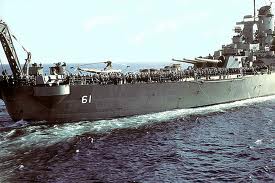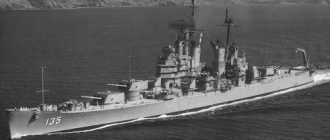Researching the USS Iowa BB-61 from the Korean War? Read more about the role of USS Iowa BB-61 during the war in Korean…
During the Korean War the battleship USS Iowa BB-61 also known as The Big Stick was the lead ship deployed as part of a naval mobilization assisted by United States military to ward off the invasion of South Korea.
In 1950 when North Korea invaded South Korea, the United States participated in the liberation of that country under the auspices of NATO and the UN. The USS Iowa BB-61 was reactivated in service during July 1951 and sailed out for Korea’s in 1952.
Upon the release of the sister ship USS Wisconsin BB-64, the vessel became the flagship with Vice Admiral Robert P. Briscoe, Commander of the Seventh Fleet.
Participation of USS Iowa BB-61 in the Korean War
The first guns were fired off from the battleship on April 8, 1952 with the intent of destroying a supply line of North Korea at Wonsan-Songjin.
The ensuing days saw the battleship participate actively by engaging North Korean forces with the aim of destroying their supply lines, pre-determined gun positions and military personnel concentrations.
In order to support South Korea the battleship continued shelling the enemy’s positions on April 13, and ended up achieving a massive victory, especially in terms of the damage caused to the enemy’s forces. The attack from this gunship resulted in the complete destruction of 6 gun placements, a divisional headquarters and the deaths of hundreds of North Korean soldiers.
The battleship USS Iowa BB-61 continued serving in the Korean War by entering the Wonsan Harbor and completely destroying observation posts, warehouses, as well as railroad marshaling yards by continuously shelling those positions.
It went on to assist the United Nations’ flotilla, which was stationed around Kosong to aid the ground forces. The first combat action above the 38th parallel that USS Iowa BB-61 participated in during the Korean War was actually on April 20.
The battleship moved in to destroy railroad lines and four railroad tunnels at Tanchon. It moved on to Kosong and Chindong to bomb different North Korean positions in that locale for a stretch of two days.
In May it moved toward the waters of Chongjin, into what was considered the industrial center of North Korea. It was located in close proximity to the former Soviet Union’s border.
Here the battleship engaged in the shelling of railroad and transportation centers and then moved on to the south in order to assist the US X Corps. During the journey to reach the new location the battleship continued to shell Songjin on its way south, destroying different bridges as well as railroad tunnels in that location, intent on causing maximum damage and crippling the mobility of North Korean supply lines.
From May through August the battleship continued to destroy different key positions along the coasts and port cities of North Korea. It was involved in certain rescue operations that saved the lives of downed pilots, wounded men from other ships and assisting other battleships by providing them firepower cover as they retreated to safe waters along with providing backup force for ground troops.
Battleship History of USS Iowa BB-61
The USS Iowa BB-61 is considered by historians to be in a class of its own. It is actually the fourth ship to be named after the 29th state of the Union, Iowa. It served during World War II and after many skirmishes on the North Korean coast it was decommissioned and became part of the Reserve Fleet of the U.S. Navy.
It was reactivated during 1984 and participated in the 600 ship naval plan during operations in the Pacific and Atlantic to combat the former Soviet Union Navy.
However, an explosion of unknown origin on the ship destroyed its gun turret number two and also resulted in the death of 47 soldiers on board. Finally it was docked at Suisun Bay in California and will be donated to charity, and will be used as a museum ship.





